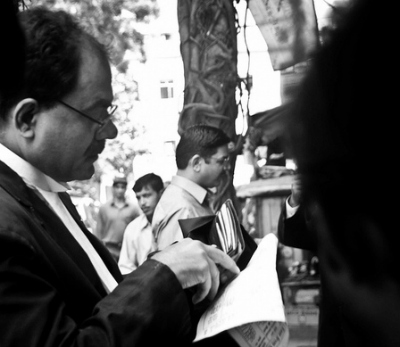 Since Orders VI, VII, and VIII of the Code of Civil Procedure, 1908 provide a framework for the drafting of pleadings (which I wrote about previously), it is relatively easier for a litigator to understand the requirements. There is however, no similar codified framework for legal opinions for clients and legal notices and as a result, a litigator naturally falls back on the practice of the chamber or firm that he is working with or for. Drafting legal opinions and notices however, presents a litigator with a wonderful opportunity to showcase and develop acumen, foresight, and a sense of discretion. Needless to say, the ingredients of an opinion and a notice differ and so does the approach.
Since Orders VI, VII, and VIII of the Code of Civil Procedure, 1908 provide a framework for the drafting of pleadings (which I wrote about previously), it is relatively easier for a litigator to understand the requirements. There is however, no similar codified framework for legal opinions for clients and legal notices and as a result, a litigator naturally falls back on the practice of the chamber or firm that he is working with or for. Drafting legal opinions and notices however, presents a litigator with a wonderful opportunity to showcase and develop acumen, foresight, and a sense of discretion. Needless to say, the ingredients of an opinion and a notice differ and so does the approach.
Understand the situation and the client before you draft an opinion
Generally speaking, a legal opinion addresses a specific query from a client. It presents the client with the options available along with their pros and cons. Since the client must be made aware of the position of the law, the outcome of legal research forms an indispensable component of an opinion but there are sensitive aspects that go beyond an exposition of the law. While one kind of opinion presents a bouquet of options to the client and stops short of recommending the way forward, the other type also strongly recommends a specific option that (in the litigator’s opinion) is the most viable and advisable. To be clear, the ultimate decision is the client’s. The difference only lies in the degree to which the litigator leans on the client and pushes an option. In my opinion, it would help to not subscribe rigidly to either school of thought because the approach must depend on (a) the situation, (b) the client’s awareness of the legal and commercial consequences, and (c) his appetite for taking risk.
For instance, if the client is not a legally savvy individual whose personal liberty is at stake in a criminal case, it is for the litigator to help the client make the choice by uncluttering the options before him. In contrast, if the matter is a civil commercial dispute and the client is a seasoned litigant who merely wants options from which he can choose, the litigator may do just that. This rudimentary illustration is not meant to convey the impression that the stakes in a civil commercial dispute are never as high as those in a criminal matter. Regardless of the situation however, in rendering a written opinion, at all points of time the litigator must be aware that his credibility and credentials are on the line each time.
You are not an oracle
 Young litigators should remember what is at stake because in their eagerness to prove themselves to their seniors and clients, they sometimes stick their necks out to such an extent that they unwittingly offer their heads on a platter to people looking for a convenient scapegoat when things don’t pan out as anticipated. Since reputation is paramount in the legal profession, the litigator must ensure that the client knows that given the several variables involved, no amount of comprehensive legal research and preparation can predict litigation outcomes with certainty. A litigator is not an oracle. Importantly, on issues where there is not enough judicial guidance, no matter how confident the litigator may be in his interpretation of the law or assessment of the situation, it is best to observe a fair degree of caution in the opinion because judicial outcomes can be bizarre no matter how clear the language of the law may be or how open-and-shut a case may seem.
Young litigators should remember what is at stake because in their eagerness to prove themselves to their seniors and clients, they sometimes stick their necks out to such an extent that they unwittingly offer their heads on a platter to people looking for a convenient scapegoat when things don’t pan out as anticipated. Since reputation is paramount in the legal profession, the litigator must ensure that the client knows that given the several variables involved, no amount of comprehensive legal research and preparation can predict litigation outcomes with certainty. A litigator is not an oracle. Importantly, on issues where there is not enough judicial guidance, no matter how confident the litigator may be in his interpretation of the law or assessment of the situation, it is best to observe a fair degree of caution in the opinion because judicial outcomes can be bizarre no matter how clear the language of the law may be or how open-and-shut a case may seem.
Prepare before you issue notice
A legal notice is the precursor to potential litigation and therefore, a litigator should pay attention to both the content and the language. To borrow from the words of Fali Nariman, notices, like suits for defamation, are often issued in haste and regretted at leisure. Since there is no one statute for legal notices, each notice is implicitly governed by the legislation which applies to a certain act or a transaction to which the notice pertains to. For instance, if the subject-matter of the notice is an alleged contractual violation, the Contract Act and the terms of the contract have an obvious bearing on the ingredients of the notice. Similarly, if the notice alleges an infringement of trademark rights or copyright, the respective legislations and causal facts dictate the elements of the notice.
Before issuing a notice, the litigator should be satisfied that the facts placed before him by the client are reliable and give rise to at least an arguable cause of action because some legislations provide remedies to the recipient of the notice (“noticee”) for groundless threats or allegations. That being said, it would help to keep the language of the notice slightly open-ended because at the time of issuing the notice, one may not always be in possession of complete facts, and the object of the notice may be to test waters and elicit potential defenses from the noticee who is a prospective defendant or even a plaintiff. If the object of the notice is to forewarn the noticee of the existence of a right and thereby lay the foundation for the wilful violation of rights or contractual terms, as the case may be, the language of the notice and the contents of the allegation must clearly identify the scope of the right or the import of the contractual term, although this could result in limiting the scope of pleadings in litigation by estoppel. This clearly calls for a fair bit of due diligence before the notice is issued.
Limit your notice to its role in a potential litigation
Sometimes, in cases involving reputation, the tendency is to resort to puffery or to exaggerate. This is typical of trademark litigation where the trademark owner claims that his products are sold across the length and breadth of the country. In doing so, he inadvertently allows the noticee to initiate legal proceedings at a place of his choosing because the law legitimately permits him to do so. In one such case, a Division Bench of the Delhi High Court held that by claiming in a legal notice that its products were sold across the length and breadth of the country, the defendant had given the plaintiff a legitimate reason to institute a suit in Delhi. Since the law is that the veracity of such a claim by the defendant can only be tested at trial, the Delhi High Court held that the plaint could not be returned under Order VII, Rule 10 for want of territorial jurisdiction. Such examples abound partly because the client may at times insist on capturing his anger, outrage, or position in harsher or more pompous language than necessary in a legal notice. But it is for the litigator to explain to the client that a legal notice forms an integral part of litigation and therefore, it is advisable to keep the language clinical and objective. Emotion too must be used only to the extent that it serves to further the legal merits of the case. Again, this is an exercise in client-counselling, which forms a large part of the litigator’s job.
In the next post, I will proceed to discuss the use of interim reliefs available under the Code of Civil Procedure, 1980.
J.Sai Deepak, an engineer-turned-litigator, is an Associate Partner in the Litigation Team of NCR-based Saikrishna & Associates. Sai is @jsaideepak on Twitter and is the founder of the blawg “The Demanding Mistress” where he writes on economic laws, litigation and policy. All opinions expressed here are academic and personal.
